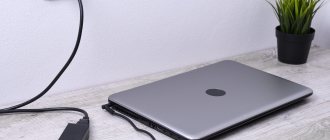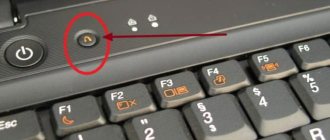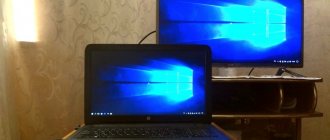As you know, the more careful you treat a device, the longer it can serve its owner. This unspoken rule is also true for laptops, especially its battery.
For obvious reasons, a laptop battery is one of the most important parts of the entire device. Even though it may be made using quality materials, its maximum service life is around 5 years.
And if you don’t take care of it, then you can use it for even less time. This is primarily due to improper charging of the device’s battery.
What are the types of laptop batteries and how to charge them
Before we talk about how you should (or should not) charge the battery of this type of equipment, you need to understand what type is installed in the laptop.
After all, the recommendations greatly depend on what main power source is installed. They come in three types - each with its own advantages and disadvantages.
Nickel-Metal Hydride Laptop Battery
They are also designated as Ni-MH. Most often, this alkaline energy source is used to power digital equipment, children's toys and other household appliances.
You can now see such a battery in a laptop only in fairly old models, and charging them is out of the question.
In the current generation of these devices, Ni-MH is no longer used, as it has modest energy consumption and service life.
Laptop battery Ni-CD
Nickel-cadmium power supplies are also not as popular as laptop batteries. It is extremely rare to see them now.
Their main field of use is in powering portable tools (drills, electric saws, grinders), and the same for vehicles with ultra-high power. But this type of battery hardly needs to be charged at home.
Lithium-ion laptop battery
The most common power sources. They can be found not only in these types of devices, but also in smartphones, photography equipment and other devices.
The reason for their popularity is their durability, good energy reserves, and compact size (which is especially important for laptops).
They can be charged and discharged up to 1000 times, this is a guaranteed safety margin. Typically, such a reserve is enough for several years of trouble-free operation.
In addition, Li-Ion batteries have low self-discharge rates. This can be considered their huge advantage, since laptops can remain idle for a long time (or they may not be charged for a long time), which means their charge level drops minimally. Therefore, for laptops that are used offline, they are of greatest benefit.
What kind of batteries are installed in laptops?
There are varieties:
- Nickel-cadmium (NiCad): characterized by heavy weight, limited service life (withstands up to 350 charge/discharge cycles). This reduces the cost of the battery. It is used at low and high temperatures. Due to its large size and limited service life, this type of battery is found only in older computer models.
- Nickel-metal hydride (NiMh): characterized by large sizes, but at the same time they can be used longer than the first of the considered options. This type of battery is considered one of the most environmentally friendly. It does not contain hazardous substances. However, today this type of battery is also rare due to its large size.
- Lithium-ion batteries (labeled Li-ion): used more often due to their light weight and compact dimensions. These parameters allow you to reduce the weight of the laptop. In addition, the Li-ion battery lasts longer than the considered analogues.
The only disadvantages include a ban on use in low temperature conditions. In this case, the operation of the battery is disrupted (capacity decreases). To maintain the functionality of the device, it must be turned on at temperatures above +5°C.
Appearance of a lithium-ion battery (labeled Li-ion).
- Lithium polymer (Li-pol): this is an improved version of the Li-ion battery, using polymer in its production. This material acts as an electrolyte. The main advantage is small dimensions. This type of battery is lightweight.
The standard model of such a battery cannot deliver high current, which reduces its scope of application: Li-pol devices are installed in compact equipment. There are also power batteries. They are characterized by their ability to deliver high current.
Charge a laptop battery: how to do it correctly
In order for a laptop battery to fully use up its allotted resource, it is necessary not only to use it correctly, but also to charge it.
First of all, batteries are damaged by such things as uncertified chargers, as well as adapters (including homemade ones), plus if you charge the laptop from them constantly.
Don’t forget that the device should only be sent to professionals for repair. Amateurs most often break the power supply when trying to repair it.
How long does it take to charge the battery?
As mentioned, the charging time of a modern laptop is not limited thanks to the controller that controls the process. The minimum time to fully charge a power source can be found by dividing the battery capacity by the rated current of the charger, and adding to the resulting value a correction factor in the range of 0.1-0.2 to take into account the loss of efficiency.
Thus, a battery with a capacity of 9,000 mAh (9 Ah) from a charger with a rated current of 3 A will charge on average from 3 hours 18 minutes to 3 hours 36 minutes.
The material was prepared with the participation of the 3delectronics.ru team.
If you have just purchased a laptop
This is the most preferable option, since the laptop battery was practically not charged, which means that the resource was not used.
Also included as standard is an original adapter that allows you to replenish energy without any problems.
In order to charge it, you just need to connect the adapter to the appropriate socket and plug it into the electrical network. With standard chargers, no problems should arise during use.
The battery currently used in laptops does not have the so-called “memory effect”. Accordingly, there is no need to start “rocking” it, i.e. Fully charge and fully discharge the battery two or three times. Therefore, there is no need to do any “dancing with a tambourine” when charging. If charging is necessary, simply connect the adapter to the laptop, and its plug to the mains power supply and wait until the battery is replenished to the required level.
However, just for fun, you can conduct a small experiment with a new laptop. To do this, you will need to fully charge the device, up to 100%, measure the time in any convenient way, and use it in standard mode, bringing it to 0% charge (then compare the actual operating time and the one declared by the manufacturer). This will allow you to plan your work with the laptop much more clearly and roughly understand how much it will be enough for autonomous work.
Is it possible to work while charging?
When working on a laptop from the mains with the battery connected, it will be charged. There are different opinions about whether this mode is harmful to the battery.
Thus, Acer believes that there is no need to remove the battery when operating from an electrical network. But if you don't plan to use the battery for several days, it's best to remove it and store it in a cool, dry place.
Apple does not recommend removing the battery. Without a battery, the computer automatically reduces processor performance to prevent the laptop from shutting down.
Expert opinion
Alexey Bartosh
Specialist in repair and maintenance of electrical equipment and industrial electronics.
Ask a Question
It turns out that the power supplied by the Apple power adapter was not always enough to provide the gadget with energy.
Asus recommends discharging the battery to 50% at least once every two weeks. Dell says that constant operation from the power adapter does not cause any problems. In addition, there are now laptop models with non-removable batteries.
If the device is used every day
Despite the fact that these batteries have a lot of positive aspects, they are not without certain problems. Thus, one of the main problems of Li-Ion batteries is that they have a rather limited discharge-discharge cycle.
Even though it can survive 1000 such cycles (which is not too little), it still begins to develop its accumulation properties. This entails the inability to use the device autonomously for as long as before.
The only advice that will help “stretch” the operating time of the battery is that you should not completely discharge the battery and charge it to the limit.
If your laptop is constantly in use, then as soon as the level drops to 20% or below, it should be included in the charger.
This will also make it possible to extend its “period” of life significantly longer than that same thousand cycles (which means it can be used autonomously for longer).
There is also a little trick that will increase the life of the battery. The built-in controller found in the laptop system turns off charging as soon as the indicator reaches 100%. However, if you manually (or using some programs) turn off battery charging at 80%, you can significantly increase the battery life.
Of course, this will somewhat reduce the usability of the laptop, but it is better to work a little less than to have problems with the battery in a few years.
Ideally maintain from 20 to 80%
Those who discharge the battery to zero and those who constantly charge it are equally mistaken. The optimal charge level is 20-80%: it increases the battery life three to four times up to 1100-1400 full discharge-charge cycles. As a rule, the device is usually discharged to 20%, but not less.
You can monitor how quickly a laptop will discharge from 100 percent to the desired level experimentally. First, set up a low battery notification on your computer.
- On Windows 7: “Control Panel” → “Hardware and Sound” → “Power Options”. Next to the current plan, select “Configure power plan”, then “Change advanced power settings”. In the window that opens, expand the “Battery” list, in it - “Low battery level” and “Low battery notification”. In the first item, set “On Battery” to “20%”, in the second, check that the battery notification is enabled.
- On Windows 10, getting to the Energy Options window is a little more difficult. “Settings” → “System” → “Power and sleep” → “Advanced power settings”, then see above.
Tracking the 80% mark is more difficult if the device is charging while turned off or at night. You can track the discharge time using a timer, but it will not coincide with the time it will take to charge the gadget.
For more accurate measurements, start the laptop in battery calibration mode - first fully charge, then discharge to 2-3%. This can be done manually or through special programs - for example, Battery Eater, BatteryCare or Battery Optimizer (all three are free). You need to calibrate the battery no more often than once every two to three months: if more often, the battery will deteriorate.
Is it possible to constantly charge a laptop from the network and is it harmful?
There is an opinion that if you remove the battery during stationary operation (when the adapter is constantly connected to the network and charges the device), it will last much longer. And many believe in such untested theories.
In fact, everything is somewhat more prosaic and simpler. If the adapter is constantly connected to the network (and therefore charges the laptop), then the battery is not involved in this process and, accordingly, does not consume its resource.
However, the question arises: where does the energy go in this case?
It's simple. When a laptop is charged in this mode, the battery resource is practically not used, since it falls out of this energy supply scheme.
Instead, all the power that comes in is transferred to the motherboard, which can cause the battery to last much longer than usual. However, this rule is only relevant for modern laptop models.
Older versions do not have such an electrical circuit, and therefore, as soon as the battery is charged, the controller turns off and the device begins to work in autonomous mode.
Do I need to remove the battery from the laptop?
Modern battery models are designed in such a way that there is no need to dismantle them, because when the 100% charge level is reached, the current supply stops, which is due to the properties of the power controller. This means that it is not necessary to remove the battery.
There are a number of exceptions:
- you plan to work on a laptop for a long time when connected to a power source, and constant exposure to high voltage helps to reduce the battery capacity;
- the computer and battery become intensely heated;
- it is planned to turn off the laptop for a long time, while the charge level is deliberately reduced to 40-50%, after which the battery is removed.
It is not recommended to take a break from using such equipment for more than 5 months. When this rule is ignored, the aging process of the battery accelerates.
A safe way to remove the battery from a laptop.
The correct order for storing laptop batteries
If there is a need to store the battery separately from the device, you must follow a few simple rules. Before sending the battery for long-term storage, it is necessary to charge it to 80% (or better yet, to 100%).
This is necessary so that the battery can survive this time when it is not in use. Of course, Li-Ion has a low level of self-discharge, but it is still present, and therefore it is not recommended to put it away completely.
It is especially important to note that the level of self-discharge will begin to increase significantly if you store the laptop battery in a damp room.
It is best to choose a heated room for this matter, since temperature changes negatively affect the battery. If necessary, you should charge it once a week or several times so that the charge does not drop below 80%.
It is also worth monitoring the temperature at which the laptop battery is stored. Immediately exclude places that receive direct sunlight, near heating (batteries or special devices) or simply on a windowsill, since overheating has an extremely bad effect on the performance of this device and reduces its performance. It will be bad if you overcool the battery.
If you do not charge the battery before storing it, it may happen that it goes into a deep discharge. It is similar to the one found on cars, and it can only be “revitalized” by turning to specialists for help (since the controller simply will not be able to see the battery and will not allow it to charge).
How to extend your battery life
A laptop user wants his laptop to last longer without needing to be recharged. Here are several ways to extend battery life:
- Decrease screen brightness.
- Quit all unused programs.
- Disable Wi-Fi if the Internet is not in use, for example, when watching a movie from a hard drive or DVD.
- Use hibernation mode instead of sleep. In this mode, all working information is saved on the hard drive, and after that the gadget does not use electricity.
Connecting Power Bank to laptop via USB
Many power bank users think that this device can be connected to a laptop using a USB cable. This is indeed possible, but only if you have the latest USB 3.1 port on your laptop. This type of connection also has another name - Type C.
If your laptop does not have the above connection type on board, but only USB 2.0 and 3.0, then under no circumstances will you be able to charge the laptop via a USB cable. The reason for this is quite simple: ports 2.0/3.0 have a voltage transmission of only 4.5 volts, this power may be suitable for a tablet and smartphone, but charging a laptop requires at least 30, and best of all, 50 volts and above.
How to choose a Power Bank to charge a laptop
To understand the question of whether it is possible to charge a laptop from a Power Bank, you should make the right choice when purchasing it. When buying a mobile charger, pay attention to original devices with high-quality batteries from popular manufacturers.
As a rule, Chinese counterfeits have low-quality batteries. At the same time, manufacturers of such devices promise the consumer a capacity of 20,000 mAh, but in reality the promised volume available to the user is not observed. Accordingly, the output current on such a device will be low and will definitely not be enough to charge the laptop. By the way, connecting such a Power Bank to a PC will be very problematic.
The average laptop has a battery with a capacity of 10,000 milliamp-hours, so to effectively use a portable charger you need either a similar capacity or slightly less. This will allow you to charge your portable personal computer, if not 100 percent, then at least 70-80 percent, which is a pretty good result.











